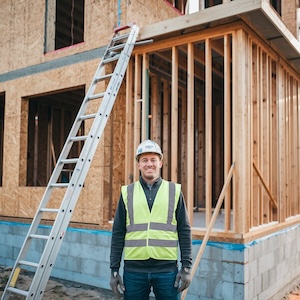Maintenance & Upkeep
Maintenance and Upkeep of a Custom Home
Owning a custom home is a significant investment, and maintaining it properly ensures longevity, comfort, and efficiency. Unlike standard homes, custom-built homes often feature unique materials, intricate designs, and specialized systems, requiring a more tailored maintenance approach. This guide provides a comprehensive breakdown of everything you need to keep your custom home in pristine condition.

1. Exterior Maintenance

Roofing
- Inspect the roof, if possible yourself, twice a year for damage, loose shingles, or leaks.
- Clean gutters and downspouts regularly to prevent water buildup.
- Check for moss or algae growth and clean with a mild bleach solution.
- Ensure flashing around chimneys and vents is intact.
- Schedule a professional inspection every few years to identify potential problems early.
- Consider applying a protective sealant to extend the life of the roofing material.
Siding & Paint
- Wash siding annually to remove dirt and mold.
- Repaint or reseal wood, stucco, or brick exteriors as needed to protect against weather damage.
- Check for cracks or warping, especially in custom materials.
- Power wash brick or stone exteriors to prevent dirt buildup.
- Inspect and replace caulking around windows, doors, and joints to maintain a tight seal.
Windows & Doors
- Clean and inspect window seals to prevent drafts.
- Lubricate door hinges and handles to ensure smooth operation.
- Check caulking around windows and doors annually.
- Ensure weather stripping is intact and replace as needed.
- Inspect for any signs of rot or warping in wooden frames.
- Clean glass with streak-free cleaners and inspect for cracks or chips.
Landscaping & Drainage
- Trim trees and bushes away from the house to prevent damage.
- Maintain proper grading around the foundation to prevent water accumulation.
- Inspect irrigation systems seasonally for leaks or inefficiencies.
- Aerate and fertilize the lawn to keep it healthy year-round.
- Remove weeds and apply mulch to maintain curb appeal.
- Install proper drainage systems to prevent flooding or pooling water.
2. Interior Maintenance

HVAC System
- Change air filters every 1-3 months to maintain air quality.
- Schedule annual professional inspections and servicing.
- Clean air vents and ducts periodically to remove dust buildup.
- Ensure thermostats and smart home climate controls are functioning properly.
- Inspect the condenser and evaporator coils for efficiency.
- Check for leaks in refrigerant lines and address any airflow issues.
Plumbing
- Inspect for leaks under sinks, around toilets, and in the basement.
- Flush the water heater to remove sediment build-up.
- Test water pressure and adjust if necessary.
- Check sump pumps and drains to prevent flooding.
- Insulate pipes in colder months to prevent freezing.
- Replace worn-out washers in faucets to prevent drips.
Electrical System
- Test and replace smoke and carbon monoxide detector batteries annually.
- Inspect wiring, especially if the home has custom electrical layouts.
- Ensure outlets, GFCIs, and breakers are in good condition.
- Install surge protectors for valuable electronics and appliances.
- Hire a licensed electrician for periodic inspections.
- Ensure backup power systems, such as generators, are operational.
Flooring & Walls
- Clean hardwood floors with appropriate products to prevent damage.
- Shampoo or steam clean carpets periodically.
- Inspect tile grout and reseal if necessary.
- Patch up small wall cracks or paint chips promptly.
- Consider refinishing floors every few years to maintain their appearance.
- Address water damage issues immediately to prevent structural damage.
Basement & Attic
- Check for signs of moisture or mold.
- Ensure proper insulation is in place for energy efficiency.
- Look for signs of pest infestation.
- Inspect the foundation for any visible cracks or movement.
- Ensure attic ventilation systems are clear of obstructions.
3. Seasonal Checklists

Spring & Summer
- Inspect and clean gutters and downspouts.
- Check roof shingles and exterior paint for wear.
- Service HVAC system before heavy summer use.
- Open and clean windows for fresh airflow.
- Pressure wash driveways and patios.
- Test irrigation systems and adjust for optimal performance.
- Seal cracks in driveways and walkways.
- Check for insect infestations, particularly termites and ants.
Fall & Winter
- Clean and inspect chimneys and fireplaces.
- Insulate pipes to prevent freezing.
- Test heating systems before winter.
- Remove leaves and debris from the yard to prevent mold.
- Seal gaps in windows and doors to maintain heating efficiency.
- Store outdoor furniture and prepare landscaping for cold weather.
- Inspect attic insulation and vents for signs of damage or blockage.
4. Smart Home & Technology Upkeep

- Update firmware and security settings on smart devices.
- Test backup power supplies for security systems.
- Ensure home automation systems function correctly.
- Backup important home data, such as security camera footage.
- Check for software updates on home security and energy management systems.
- Inspect and clean sensors on motion detectors and smart thermostats.
5. Long-Term Repairs & Renovations

- Kitchen & Bathroom Upgrades: Inspect countertops, cabinets, and fixtures for wear and update as needed.
- Structural Integrity: Check for foundational issues, especially in homes with custom-built designs.
- Energy Efficiency Improvements: Upgrade windows, insulation, and appliances over time.
- Roof Replacement: Depending on material, replace every 20-50 years.
- Lighting Enhancements: Install energy-efficient lighting or smart systems for better control.
- Garage & Storage Maintenance: Organize and maintain storage spaces to maximize utility.
- Deck & Patio Maintenance: Reseal wood surfaces and inspect for rot or loose boards.
6. Budgeting & Cost Planning

- Annual Maintenance Fund: Allocate 1-2% of your home’s value for upkeep.
- Emergency Repairs: Have a savings buffer for unexpected repairs.
- Insurance Coverage: Ensure you have adequate coverage for structural and system failures.
- Home Service Contracts: Consider warranties for appliances and major home systems.
- Plan for Major Renovations: Budget for long-term improvements to maintain property value.
